We are witnessing a remarkable transformation of CO2 emissions in the United States building sector.
In the U.S., from the Industrial Revolution beginning in the late 1700s until 2005, the building sector grew alongside sector energy consumption and CO2 emissions. This makes sense. Each year, we added about 3 billion to 5 billion square feet in building stock, and those buildings needed energy—electricity, natural gas, heating oil—to operate, driving up the sector’s consumption and emissions. In 2005, however, something extraordinary happened: As shown in the charts below and outlined in a recent report from the U.S. Energy Information Administration, building operating energy and emissions decoupled from building sector growth.
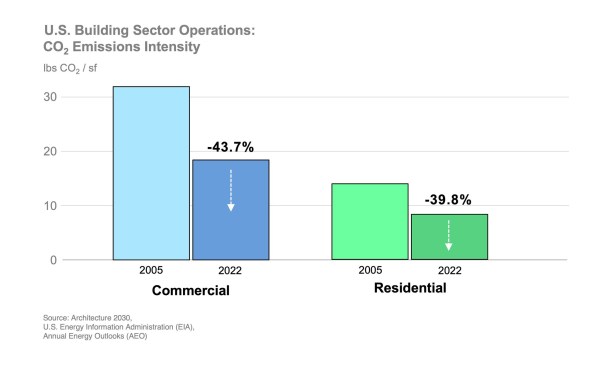
courtesy Architecture 2030
- Since 2005, the carbon intensity of the entire U.S. building stock (CO2 emissions per square foot of floor area) declined by 39.8% for residential buildings and 43.7% for commercial buildings.
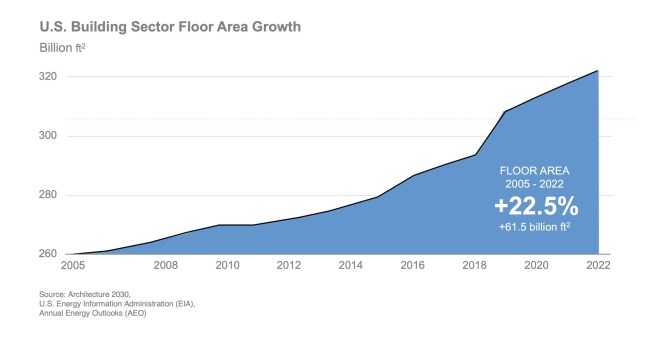
courtesy Architecture 2030
- From 2005 to 2022, the U.S. added 62.5 billion square feet to its building stock—the equivalent of adding about six Boston-sized cities each year—but building sector operating energy consumption did not increase (it decreased by 3.5%) and CO2 emissions declined 28.4%.
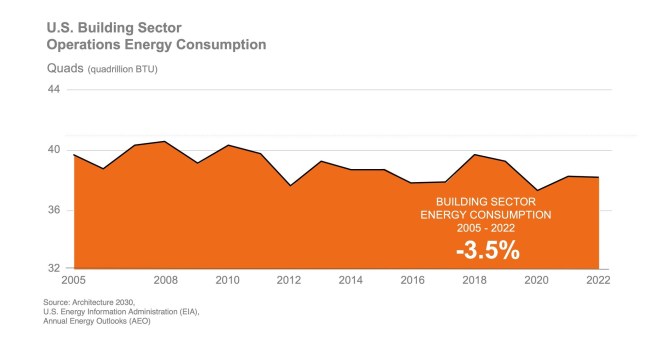
courtesy Architecture 2030
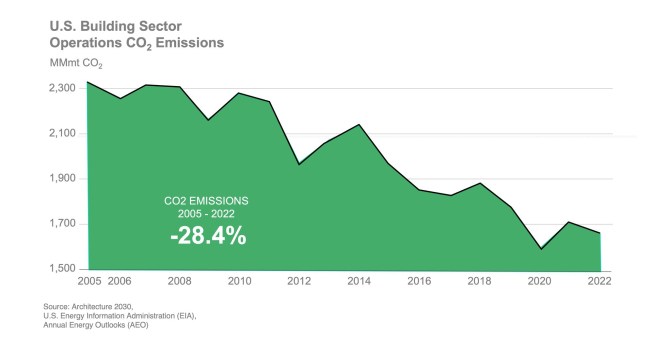
courtesy Architecture 2030
- From 2010 to 2022, residential and commercial building energy consumers saved approximately $530 billion compared to the energy costs initially forecast in 2010. That means more money was being spent throughout the economy on clothing, food, education, travel, electronics, construction, equipment, and housing.
More than 70% of all electricity in the U.S. is destined for building operations, but renewable electricity generation is growing exponentially. That increase, coupled with low-to-zero carbon design and planning; new federal climate programs and incentives; local governments advancing electrification and clean power plans; and zero carbon standards for new buildings and major renovations puts us on track to meet or exceed a 50% building sector CO2 reduction by 2030.
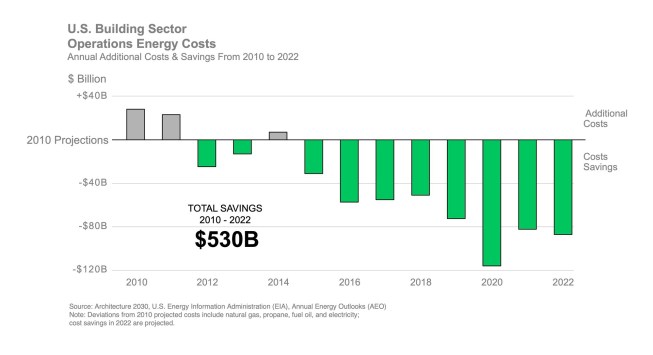
courtesy Architecture 2030
But what explains these numbers? Part of this predicted success stems from a notable worldwide interest in renewables, due in part to the Russian invasion of Ukraine, supply disruptions, and higher prices for fossil fuels, and is underlined by the cost and security benefits of locally generated renewables. The International Energy Agency projects worldwide renewable electricity to double over the next five years and become the world’s largest source of electricity generation by 2025.
Countries are also setting ambitious new targets for emissions reductions, and unprecedented public investments in renewable energy will unlock technological and efficiency advances. Understanding the outsize contribution that buildings and the built environment make to greenhouse gas emissions—building materials, construction, and sitework can account for as much as 50% of the carbon footprint of new buildings over their lifespan—158 of the 196 parties to the Paris Agreement now include buildings in their emissions reduction targets.Fortunately, new design, planning strategies, and calculation tools—such as EC3, Carbon Smart Materials Palette, Pathfinder, Tally, CARE Tool, EPIC, and One Click LCA—are gaining popularity.
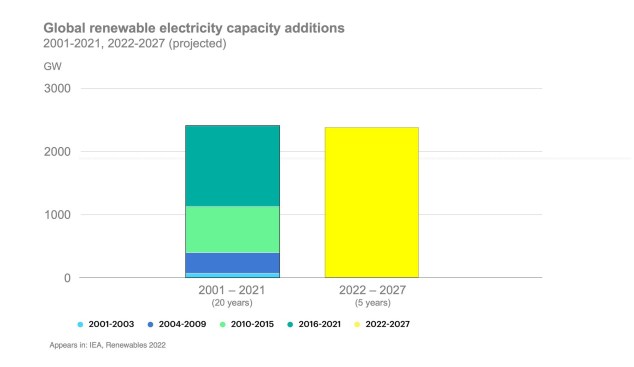
courtesy Architecture 2030
Why is all this so important right now?
The Intergovernmental Panel on Climate Change released its latest report on the climate crisis, the AR6 Synthesis Report: Climate Change 2023, which provided both dire and optimistic findings. We are on the brink of irrevocable global damage, explains the report, but we can limit the worst consequences of climate change if all countries and sectors embrace greatly accelerated, and successful, emissions reductions to meet the Paris Climate Agreement’s 1.5˚C or well below 2˚C global warming target.
The good news is that nothing succeeds like success—it generates momentum, is a great motivator, leads to further opportunities, discredits misinformation campaigns, and offers, in this case, a proven sector decarbonization model—a model that, in our rapidly urbanizing world, we desperately need.
A version of this article was first published in The Hill on March 15, 2023. It has been updated with links and new charts illustrating current data. All building sector floor area, operating energy and emissions statistics cited above are derived from the U.S. Energy Information Administration’s “Annual Energy Outlook 2005 to 2022.”
